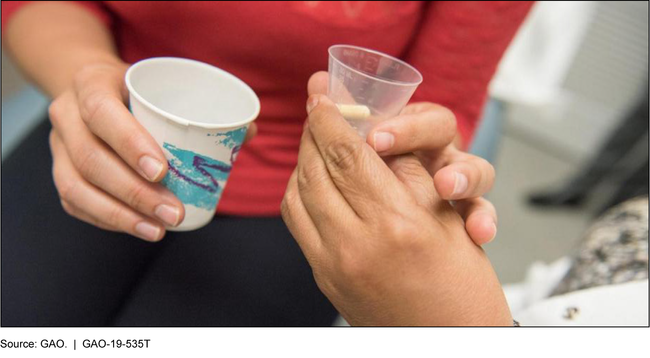Drug Policy: Assessing Treatment Expansion Efforts and Drug Control Strategies and Programs
Fast Facts
Over 70,000 people in the U.S. died from drug overdoses in 2017. Combining behavioral therapy with medication (like buprenorphine) can help people who are addicted to or misuse opioids. However, many in need don't have access to medication-assisted treatment.
This testimony discusses our work on access to such treatment, including efforts by the Office of National Drug Control Policy. For example, we found that
Federal laws, practitioner availability, and other factors can limit access
Federal agencies are working to expand access but could improve performance measures to determine if efforts are successful or if new approaches are needed

A doctor handing a patient medicine in a small clear cup
Highlights
What GAO Found
In an effort to reduce the prevalence of opioid misuse and the fatalities associated with it, the Department of Health and Human Services (HHS) has made expanding access to medication-assisted treatment (MAT) for opioid use disorder a priority since 2015. MAT is an approach that combines behavioral therapy and the use of certain medications like methadone and buprenorphine. GAO reported in September 2016 that several factors could affect patients' access to MAT, such as availability of qualified practitioners and their capacity to meet patient demand. GAO also reported in October 2017 on HHS efforts to expand access to MAT for opioid use disorder and recommended, among other things, that HHS establish measures to better determine progress toward goals. While HHS established performance measures with targets to increase the number of prescriptions for certain MAT medications, it has not yet fully implemented this recommendation. Further action to measure the treatment capacity of providers would help HHS determine whether a sufficient number of providers are becoming available to evaluate and treat patients who could benefit from MAT.

The Office of National Drug Control Policy (ONDCP)—responsible for coordinating and overseeing efforts by more than a dozen federal agencies to address illicit drug use—issued the 2019 National Drug Control Strategy on January 31, 2019. The Strategy encourages the use of evidence-based approaches to treatment and making MAT a standard of care for opioid addiction. However, as GAO testified in March 2019, the Strategy does not include certain information required by law, such as annual objectives that are quantifiable and measurable. Further, while the Strategy lists some items that it designates as measures of performance or effectiveness related to MAT, it lacks information on the current level of treatment access or any associated timeline by which ONDCP hopes to achieve desired results. Such information could help prioritize activities across federal agencies and measure progress over time, which previous GAO work has shown to be important for achieving results. ONDCP's responsibility to develop the National Drug Control Strategy and coordinate among federal agencies offers the agency an opportunity to guide activities to address the unprecedented number of drug overdose deaths. As part of its ongoing work, GAO will continue to assess ONDCP's efforts and consider recommendations as appropriate. GAO plans to issue a product by the end of the calendar year.
Why GAO Did This Study
Over 70,000 people died from drug overdoses in 2017, according to the most recently available Centers for Disease Control and Prevention data. Opioids are currently the main driver of these deaths. For people who are addicted to or misuse opioids, MAT has been shown to be an effective treatment. GAO has a body of work on drug policy, including on treatment for opioid use disorder and on ONDCP's coordination and oversight of federal drug control efforts. GAO also identified federal efforts to prevent drug misuse as an emerging issue requiring close attention in its March 2019 High Risk report.
This statement includes information from GAO's 2016 and 2017 reports on access to MAT for opioid use disorder, including selected recommendation updates as of May 2019. It also includes information from GAO's March 2019 testimony with preliminary observations on the 2019 National Drug Control Strategy and on GAO's ongoing work regarding ONDCP's efforts. For recommendation updates, GAO reviewed HHS documents and spoke with HHS about its recent efforts.
Recommendations
GAO has previously recommended that HHS establish performance measures with targets to better gauge progress toward achieving agency goals for expanding access to MAT. HHS concurred and has taken some steps to address the recommendation.
